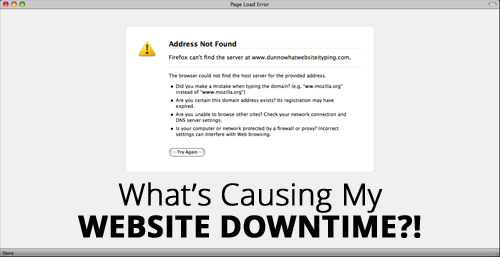What’s Causing Your Website Downtime?
Having a website that’s constantly going down or becoming unavailable can be incredibly frustrating for both users and webmasters. These frustrations can mean your followership may chose to abandon your website, losing valuable traffic and ultimately revenues for your website. There are a number of reasons that a website may be down, so let’s take an in-depth look at the top 5 reasons for your website downtime.
Poor Quality Web Hosting
It’s no secret that not all web hosts are created equally, and some hosts in particular are notorious for being down. These are often budget hosts that oversell their servers, or allow spammers to sign up for multiple accounts and hog server resources. This isn’t to say that there good quality budget hosting is an oxymoron; it’s just that the existence of it may be relatively rare. The old saying of “you get what you pay for” tends to be true more often than not when it comes to web hosting. With that said, there are also some budget hosts that outperform more expensive hosts because they are smaller companies, and may take more care in maintaining their servers. Again, hosting can be a very subjective and varied experience, but that doesn’t change the fact that low quality hosting, regardless of price, is one common reason for downtime issues.
DNS Problems
Whether you’re waiting on the DNS to propagate or have an incorrectly configured A record, there are a number of reasons why problems with the DNS could cause your site to be down. Sometimes it’s a simple as misspelled nameservers at your domain registrar, and other times it may be more complicated. Whatever the reason, the DNS can sometimes be the culprit when it comes to a website that doesn’t load.
DDoS Attacks
If you’re not familiar with what a DDoS attack is, it’s a denial of service attack, where a person or group of people use multiple computers to flood a server with requests in order to overwhelm it, essentially crashing it or causing it to freeze, rendering sites hosted on the server unavailable. There have been a number of high profile DDoS attacks over the years, but even if you have a small blog and happen to share a server with someone who’s targeted, you could be at risk for something like this. More expensive hosts have a way of mitigating the damage that a DDoS attack can cause, but nevertheless, they still remain problematic for many website owners.
Hackers/Breaches
There are a number of ways that hackers or other individuals with malicious intent can take over a server or website and crash it or cause it to become unavailable. This can happen even if you’ve done nothing to invite an attack because some hackers employ bots that go out and search for websites with known vulnerabilities, and when they find one—they strike! And when they do, an affected site may be unavailable for an extended amount of time. Attacks can also happen if you accidentally download compromised software, however, this can easily be avoided. Tools like StandAloneInstaller.com can help you ensure that the software you’re downloading is clean and free of spyware or other malicious code.
CMS Issues
Whether your website is built on WordPress, or another type of CMS, there are often issues that arise with the on-site software that can cause downtime. With WordPress, incompatible plugins, database errors, and other conflicts can be responsible for a site loading a blank page, partially loading, or not loading at all. There are also issues inherent to other content management systems that can cause the same type of downtime. It’s also important to be vigilant about maintaining your site, and there are a number of things that you should check on a recurring basis in order to make sure that it’s operating properly.
At this point, it should be clear that there are a number of issues that can cause downtime at any moment, and if you aren’t monitoring your site for uptime/downtime, you may never know until you’ve lost customers, readers, money, or all of the above!
